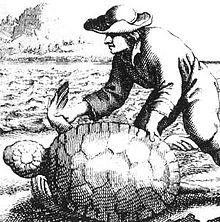
The Cayman Islands are a British overseas territory located in the Caribbean that have been under various governments since their discovery by Europeans. Christopher Columbus sighted the Cayman Islands on May 10, 1503, and named them Las Tortugas after the numerous sea turtles seen swimming in the surrounding waters. Columbus had found the two smaller sister islands (Cayman Brac and Little Cayman) and it was these two islands that he named "Las Tortugas".
The 1523 "Turin map" of the islands was the first to refer to them as Los Lagartos, meaning alligators or large lizards,[1] By 1530 they were known as the Caymanes after the Carib word caimán for the marine crocodile, either the American or the Cuban crocodile, Crocodylus acutus or C. rhombifer, which also lived there. Recent sub-fossil findings suggest that C. rhombifer, a freshwater species, were prevalent until the 20th century.
- ^ Roger C. Smith, The maritime heritage of the Cayman Islands, 2000 p.26